

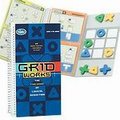
Gridworks - Thinkfun |

Chocolate Fix - Thinkfun |
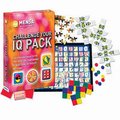
The Mensa "Challenge Your IQ Pack" contains several logic challenges. (Red version) |
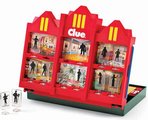

The classic game of logical deduction Clue has been simplified and turned into a solitaire puzzle game called Clue Suspects. Given six rooms, a body, up to 11 suspects, and a challenge card providing a set of clues, deduce who must be in the room with the body, and therefore be the murderer. |
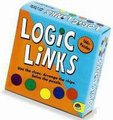
Logic Links By Mindware. Use given clues to deduce where to place colored chips. |
River Crossing puzzles begin with a river and a means of crossing the river. Some group of people, animals, and/or objects must be moved from one side of the river to the other, subject to various constraints on inter-relationships among them, and on the use of the conveyance. One must describe a sequence of crossings which get everyone from one bank to the other while obeying the constraints. It should be stated that none of these puzzles require or permit tricks such as ropes, swimming, reliance on currents, etc.
Some early U.S. patents on river-crossing puzzles include 232394 - Delan 1880, and 249963 - Loomis 1881.
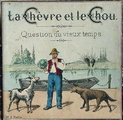
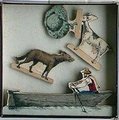 Perhaps the most well-known puzzle of the River-Crossing variety is that of the Farmer, Wolf, Cabbages, and Goat.
This has been issued in mechanical form - the French puzzle "La Chevre et le Chou" by Watilliaux circa 1885 is an example.
I have the version with the nice wooden pieces (not just carboard cutouts).
A Farmer is traveling with a Wolf, Cabbages, and Goat (don't ask why).
There is a river to be crossed, and a boat which will accommodate only the farmer, who must row every trip, and one of the others.
The goat cannot be left alone with the cabbages, which it will eat, and the goat cannot be left alone with the wolf, which will eat it.
You can try this puzzle online
here.
Perhaps the most well-known puzzle of the River-Crossing variety is that of the Farmer, Wolf, Cabbages, and Goat.
This has been issued in mechanical form - the French puzzle "La Chevre et le Chou" by Watilliaux circa 1885 is an example.
I have the version with the nice wooden pieces (not just carboard cutouts).
A Farmer is traveling with a Wolf, Cabbages, and Goat (don't ask why).
There is a river to be crossed, and a boat which will accommodate only the farmer, who must row every trip, and one of the others.
The goat cannot be left alone with the cabbages, which it will eat, and the goat cannot be left alone with the wolf, which will eat it.
You can try this puzzle online
here.
Mouseover the box below to see my answer of 7 crossings:
|
The farmer rows the goat across, then returns alone. The farmer rows the wolf across, then returns with the goat. The farmer rows the cabbages across, then returns alone. The farmer rows the goat across to finish. |
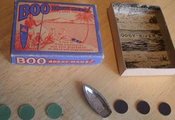 Here is another mechanical presentation:
"Boo Boogy Mans" - a "Super Puzzle" from Sherms of Connecticut.
The box contains six counters, 3 each of two different colors, A and B, and a small boat.
The inside of the box has a drawing of a river.
The problem is to use the boat, which can only hold two counters per trip, to get all of the counters across the river.
At least one counter must be in the boat every crossing.
At any time, the following constraint must be met:
the number of A counters at either shore must always be zero, or greater than or equal to the number of B counters.
In its original form, there are three missionaries and three cannibals.
The cannibals must not be allowed to outnumber the missionaries.
You can
play a version online.
Here is another mechanical presentation:
"Boo Boogy Mans" - a "Super Puzzle" from Sherms of Connecticut.
The box contains six counters, 3 each of two different colors, A and B, and a small boat.
The inside of the box has a drawing of a river.
The problem is to use the boat, which can only hold two counters per trip, to get all of the counters across the river.
At least one counter must be in the boat every crossing.
At any time, the following constraint must be met:
the number of A counters at either shore must always be zero, or greater than or equal to the number of B counters.
In its original form, there are three missionaries and three cannibals.
The cannibals must not be allowed to outnumber the missionaries.
You can
play a version online.
Mouseover the box below to see my answer of 11 crossings:
| An A and B cross together. The B stays and the A returns. Two B's cross together. One B stays and one B returns. Two A's cross together. An A and B return. Two A's cross together. One B returns alone. Two B's cross together. One B returns alone. Two B's cross together to finish. |
Dudeney gives problem #373: the boat can bear only weight 150. Four passengers must cross: weights 150, 150, 75, and 75.
Mouseover the box below to see my answer of 9 crossings:| The two 75's cross together. One stays and one returns. One 150 crosses alone, and stays. A 75 returns. The two 75's cross together. One stays and one returns. The other 150 crosses alone, and stays. The 75 returns. Both 75's finally cross together. |
Dudeney also gives problem #375: Five Jealous Husbands. Five jealous husbands traveling with their wives must cross, using a boat that can hold at most three people. Every husband was so jealous that he would not allow his wife to be in the boat or on shore with any other man unless he himself was present.
 In these puzzles, one is presented with various containers of specific capacities, and some starting quantity and distribution of
material among the available containers (sometimes an inexhaustible supply from a container of unspecified capacity is provided).
The problem is to achieve some specific distribution and quantities among the given containers,
by some sequence of transfers between containers.
Usually none of the containers are graduated, and all transfers must either fill or empty a given container completely.
Measurements of quantities besides the specific capacities of the given containers are achieved by remainders left during transfers
between containers of unequal capacity.
Sometimes one is required to empty the contents of a container back into the general supply, or discard it -
any chemistry student will tell you the former is a bad idea, while any merchant would object to the latter - but there you have it.
In these puzzles, one is presented with various containers of specific capacities, and some starting quantity and distribution of
material among the available containers (sometimes an inexhaustible supply from a container of unspecified capacity is provided).
The problem is to achieve some specific distribution and quantities among the given containers,
by some sequence of transfers between containers.
Usually none of the containers are graduated, and all transfers must either fill or empty a given container completely.
Measurements of quantities besides the specific capacities of the given containers are achieved by remainders left during transfers
between containers of unequal capacity.
Sometimes one is required to empty the contents of a container back into the general supply, or discard it -
any chemistry student will tell you the former is a bad idea, while any merchant would object to the latter - but there you have it.

 I have, however, run across the French puzzle pictured at right, called either
"La Maligne Laitiere" (The Ingenious Milkmaid)
or "La Laitiere Avisee" (The Wise Milkmaid).
(These names are reminiscent of the French edge-matching puzzle pair "Le Berger Malin" and "Le Fermier Avise.")
I have, however, run across the French puzzle pictured at right, called either
"La Maligne Laitiere" (The Ingenious Milkmaid)
or "La Laitiere Avisee" (The Wise Milkmaid).
(These names are reminiscent of the French edge-matching puzzle pair "Le Berger Malin" and "Le Fermier Avise.")
| Jug | cap-5 container |
cap-3 container |
action |
| inf. | 0 | 0 | start |
| 5 | 0 | fill 5 from jug | |
| 2 | 3 | fill 3 from 5 | |
| 2 | 0 | empty 3 | |
| 0 | 2 | transfer 2 from 5 to 3 | |
| 5 | 2 | fill 5 from jug | |
| 4 | 3 | top off 3 from 5 |
Dudeney states that Tartaglia (1500-1559) posed the following problem: Given a jug containing 24 units, and empty capacity-5, 11, and 13 containers, divide the 24 units into three equal parts (i.e. get 8 units into each of three different containers).
Dudeney poses the following in problem #365: Given two full capacity-10 containers, and empty capacity-4 and capacity-5 containers, end with exactly 3 units in each of the empty containers.
The Merchant of Bagdad (sic) appeared in Sam Loyd.
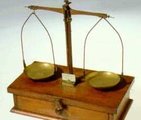 In these problems, you are given a collection of items and a weighing device which can either compare two quantities and
tell which is heavier (or if they are equal), or a digital scale which can provide a quantitative weight
in some units of the weighed
In these problems, you are given a collection of items and a weighing device which can either compare two quantities and
tell which is heavier (or if they are equal), or a digital scale which can provide a quantitative weight
in some units of the weighed
Mouseover the box below to see the answer:
| Number the bags consecutively from one to ten, in any order. On the scale, place one marble from bag #1, two from bag #2, 3 from bag #3, etc. up to all ten from bag #10. Take the reading from the scale once all the marbles are placed. Now, had there been no wrong marbles, the scale would read (1+2+3+4+5+6+7+8+9+10)x10 = 55 x 10 = 550. However, at some point you will have added N of the wrong marbles from bag #N. If the wrong marbles are in bag #1, the weight will be 549, since the 55 marbles on the scale include one which weighs 9 rather than 10. If the wrong marbles are in bag #2, the weight will be 548, since now the 55 marbles on the scale include two which are weight 9 rather than 10. In general, 550 minus the reading will tell you the number of the bag containing the wrong marbles! |
An old game show called "Let's Make A Deal" was hosted by Monty Hall. A contestant was allowed to choose one of three curtains. Behind one of the curtains was a valuable prize, while behind the other two lurked booby prizes. After the contestant made a first choice, the host would reveal a booby prize behind one of the unchosen curtains, and then give the contestant a chance to stick with their first choice, or switch to the other curtain not yet revealed, "where Carol Merrill is now standing." Either way, the contestant's final choice was then revealed, to either applause or laughter.
The puzzle asks, "Which is the better strategy for the contestant: always stick with one's first choice, or always switch?" This question caused quite a stir in the press when it was answered by Marilyn vos Savant, a noted columnist. Educated people wrote in to vehemently disagree with her answer, though it was correct. I believe the correct strategy is easy to deduce - look at the two tables below. In each table, I show the outcome of one of the two strategies, based on all the combinations of where the prize is versus the contestant's first choice. Remember, it is always possible for the host to show a booby prize behind one of the unchosen curtains.
|
|
||||||||||||||||||||||||||||||||||||||||||
A friend told me this logic puzzle question was posed during a job interview. You are given two 60-second fuses, and a lighter. Using only this equipment, time 45 seconds exactly. You cannot assume that the fuses burn at a steady rate throughout their lengths, only that they will each be completely consumed in exactly 60 seconds. You cannot cut the fuses - it would do you no good anyway, since by the previous statement there is no dependable correlation between any partial length and time.
Mouseover the box below to see the answer:
| Light both ends of one of the fuses simultaneously, along with one end of the other fuse. When the first fuse (lit at both ends) has burned out, 30 seconds will have elapsed. Immediately light the other end of the second fuse, which will have already been burning for 30 seconds from one end. Its remaining length will now be consumed in 15 additional seconds. When it is gone, 45 seconds will have elapsed from when you first lit the fuses. |
 This is a logic puzzle that asks you to achieve a specific goal ordering of objects given an initial ordering and
constraints on moving the objects.
This is a logic puzzle that asks you to achieve a specific goal ordering of objects given an initial ordering and
constraints on moving the objects.
The rules for movements are as follows:
The Exhaustive Method
One approach to a solution is an exhaustive search of all possible moves. This entails exploring all the possible legal moves (many of which will not be smart moves) while not missing any, and ideally also not unnecessarily repeating any. The search can be organized as a tree, with the initial state as the root, each node representing a particular ordering/state, and each edge representing a specific legal move. The limit of four moves defines the exact depth at which all branches must terminate. On termination, each leaf node will be either a solution equal to the goal ordering or a non-solution indicating an unsuccessful sequence of four moves. The search may terminate when the first leaf node equal to the goal state is found, unless an enumeration of all possible solutions is required in which case the entire tree must be realized. The size of this tree can be determined as follows. From the initial state, there are 6 possible moves - you can choose any group of 3 adjacent planets beginning with the second from the left (Venus) and ending with the third from the right (Neptune). In fact, at each level of the tree, from each node, there will always be 6 possible moves. In four moves, there will be 6*6*6*6 = 1296 possible branches. While the exploration of this tree can be automated, doing it by hand will be tedious and time-consuming (unless by luck a solution branch is found early). However, the problem can be approached heuristically using some puzzle-solving techniques I’ll explain below. Working Backwards First, one should look at the goal state and work backwards to see if additional constraints can be deduced which can serve to reduce the search space. This technique is sometimes fruitful when solving mazes, for example, especially mazes constructed by hand since often the psychology of the maze-maker leads them to unconsciously build in more choices near the entrance and fewer near the exit. In the case of the Aligning the Planets puzzle, we have the following. Examining the goal state we can deduce with certainty that the last (4th) move must put the leftmost 3 planets into their proper positions. This means that the 4th move must take the subset (Pluto Neptune Uranus) from somewhere in the sequence and move it to the left end intact. Furthermore, at that point the rest of the sequence must also be in its final goal form. This means that prior to this 4th move, Saturn must be on the left end. What must be to the immediate right of Saturn at this time (i.e. prior to the 4th move but after the 3rd move)? There are only two possibilities: either the (Pluto Neptune Uranus) subset must itself have come from there, or the required Jupiter must already be there, since only the 4th move remains so there would be no other way to get Jupiter to where it is needed. Let’s find a helpful way to diagram what we’ve deduced so far: Initial state: [Earth Venus Pluto Jupiter Mars Uranus Neptune Saturn Mercury] Possible States after 1st move: (6 of them)…